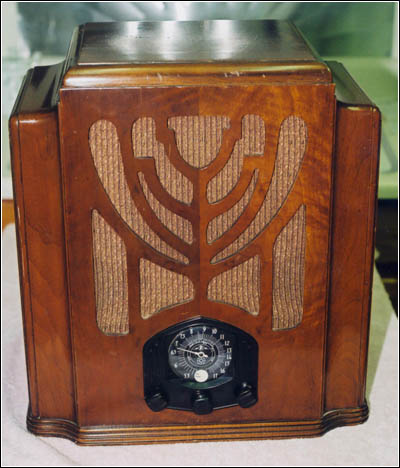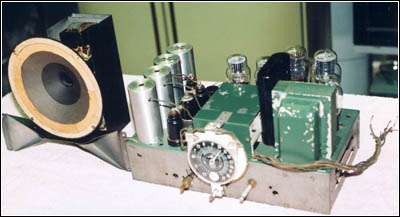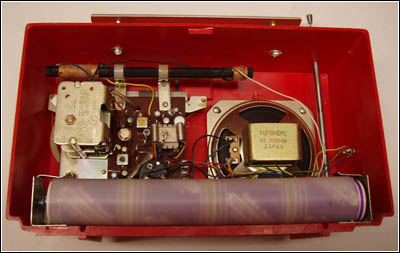Of Old Radios And Related Items--Published Monthly
The Remler 88 and
Other Early High Fidelity EffortsBY JOHN ECKLAND
Web Edition
In this article, John Eckland describes how radio manufacturers improved the fidelity of high-end console radios and how he discovered a high fidelity table model manufactured by Remler. (Editor)
The Remler 88, shown in Figure 1, is a wood tombstone radio introduced for the 1935 model year. It features a 2-way divided speaker system with a properly designed crossover. This speaker system is shown in Figures 2 and 3. The low frequency speaker is a Jensen X series, leather-edged 8-incher. The tweeter is a 2-cell horn manufactured by Remler. It appears similar in construction to a Jensen "Q" series horn used in the Zenith Stratosphere. Both speakers are of field-coil excitation. The tweeter uses a 1-inch, aluminum dome diaphragm. Figure 4 shows the tweeter disassembled.
The radio chassis features a 15-watt, all-triode, fixed bias, push-pull, class A amplifier using Type 2A3 tubes. The 2A3s are preceded by a 6A6 push-pull driver, preceded by a 6A6 input stage and conventional proportionally fed phase inverter.
The 10-tube chassis features a 2-position selectivity control -- broadcast normal and high fidelity. The amplifier is fully R-C coupled; there are no interstage transformers. It uses the new metal tubes in the tuner section. The speaker grille fretwork is cut out to allow the 2-cell horn to emanate highs, unimpeded in a crossfire, left to right pattern. The radio chassis and speaker are shown in Figure 5.
Figure 1. A Remler Model 88, a hi-fi, 10-tube radio from 1935. It featured a 2-way speaker system and a 15-watt, push-pull output stage using Type 2A3 tubes.Restoration and test
I spent two weeks at a leisurely pace in restoring the radio chassis which had been subject to a large amount of sloppy repairwork over the years. All of the usual capacitors and resistors were replaced. The coils were removed for inspection and the band-switch needed some repair. The amplifier and rectifier tubes were weak and were replaced with new ones. Finally, the whole set was given a thorough cleaning.
After restoring the set, I can report, that it plays great and does not exhibit any boominess of bass. The treble is clean and articulated. With the selectivity switch in broadcast "normal" position, all frequencies are channeled to the 8-inch speaker. Also a shunt-type treble control is in circuit.
In the broadcast "high fidelity" position, the treble shunt control is disconnected. The tweeter is now connected and series, low-pass, filter chokes are inserted into the plate leads of the output transformer, thus channeling the bass frequencies to what is now an 8-inch woofer. The result is a 2-way system.
The leather edge on the 8-inch woofer makes the cone very compliant or loosely suspended, making for a nice faithful reproduction. When the radio is operated in the high fidelity position, the addition of the tweeter gives a wonderful presence to the reproduction.
Other Table Models
Remler is one of very few manufacturers to employ the Type 2A3 in a deluxe table model set. I once encountered a very Art Deco tombstone radio made by Lafayette at the AWA meet years ago that appeared to use a pair of Type 2A3s. Philco favored the use of triode connected Type 42s in a push-pull, extended Class A amp in its Model 16B and later tombstones. Zenith followed along similar lines. Its Model 9S30 set for 1936 featured triode-connected 6F6s.
A West Coast radio manufacturer, namely Packard-Bell of Los Angeles, came out with a large sideways-oriented table radio in 1937 called the Model 50 HIFI. This radio has to be the most powerful table model ever made, in that it uses push-pull Type 6L6 tubes in beam pentode mode and operates them at maximum-rated potentials! With approximately 25 watts of power channeled into a necessarily heavy-duty Rola 8-inch electro-dynamic speaker, this set has great sound.
The Zenith Model 10S130 tombstone radio of 1937 also uses push-pull, pentode connected tube Types 6L6s or 6F6s; however, in terms of power output, the Packard Bell will blow it out of the water!
More on Early High Fidelity Efforts
It was a slow and arduous process to improve the fidelity of audio and radio equipment. By the early 1930s, the quality of broadcasting stations was improving steadily. AM stations were spaced ten kilocycles apart, and fidelity was very good, especially with live music from hotel dance orchestras. Some of the larger radio manufacturers featured sets with several speakers to help reproduce the wider range of sound. There was a trend toward making sets with same or dissimilar sized speakers, usually wired in parallel.
In 1927, Zenith Radio Corp. of Chicago made a high-end set called the "Zenith Spanish." It used TRF amplification for the front end, grid leak detection, and single-ended audio amplification, all conventional for the times. It is the earliest radio set to use a multitude of five loudspeakers that appear to be a combination of moving-coil and possibly moving armature loudspeakers. The list price of the Zenith Spanish was $2,500, enough to buy a substantial house at that time.
Figure 5. The 10-inch chassis and 2-way speaker system used in the Model 88. The black object between the variable capacitor shield and the power transformer is a Bakelite encased electrolytic capacitor block. The capacitor's case is also a Remler product. Remler had an elaborate Bakelite moulding facility, and in 1933, the company made the first Bakelite cabinet radios on the West Coast.In the early 1930s, radio manufacturers offered certain deluxe models featuring multiple speakers. A 1931 Majestic used a 12-inch "Super Colotura" low frequency speaker coupled with an early Jensen 8-inch high frequency PM speaker. Zenith sets used twin 10-inch speakers, mounted in such a way as to disperse the highs in a crossfire manner. Philco used a 10-inch, and an 8-inch speaker in a baffle board, set at an incline to direct highs at the listeners' ears. E.H. Scott used twin speakers in the 1932 Allwave Deluxe set. Virtually all speaker compartments were "open backed."
In late 1934, when the 1935 model radio sets were introduced, great strides in the improvement of fidelity took place. Zenith Radio Corp. abandoned the use of power pentodes, in recognition of the attributes of power triodes in the debut of the 25-tube Zenith Stratosphere. This radio set listed at $750 in the depths of the Depression, enough to buy a small house in Los Angeles. It features all-triode amplification of high power magnitude on the order of 50 watts RMS -- more than ten times the power of the average console radio of the time.
The Stratosphere also features variable selectivity, accomplished by mechanically changing the coupling of the coils of the IF transformers with a dual-lobe camshaft. The speaker system is fully divided with a properly designed crossover at 3,500 cycles. It utilizes two of the newly introduced Jensen A-12 woofers and a Jensen "Q" series horn tweeter.
The next high fidelity radio introduced at about the same time would be the E.H. Scott Allwave 23 Imperial. The Scott 23 also has variable selectivity and a divided speaker system using a Magnavox 12-inch speaker and two Jensen 5-inch cone type tweeters crossed over at 2 Kc.
Philco had a high fidelity model radio featuring switched variable selectivity, a 15-watt triode amplifier using Type 6A3 tubes and a single 10-inch full range speaker of special design of English origin.
The one thing these radios have in common is that they are all rather large in size and they are mostly housed in consoled cabinets. I had not been aware of any self-contained, high fidelity radios available in a table model cabinet; that is, until I happened across the Remler Model 88.
Thanks to John Kaar (a 1936 employee of Remler) of Kaar Engineering and Will Rayment of the Sargent-Rayment Co. for information on Remler. Information on Zenith was obtained from period sales brochures and service manuals. Circuit diagrams and other information from Rider Manuals were also referenced.
(John Eckland, P.O. Box 1731, Palo Alto, CA 94302-1731)
John Eckland's interest in radio goes back to 1961 when he purchased a Philco 71 Baby Grand for one dollar at a Goodwill store in Santa Cruz, California. He has been collecting and repairing radios ever since.
The El Personal Cordless Radio
By Jerry Wieland
Web Edition
Flea markets often yield intriguing items. Jerry Wieland hopes that fellow collectors can supply more information on his Japanese set with a Spanish accent. (Editor)
While browsing through a flea market, the bright red plastic table radio shown in Figure 1 caught my eye. As I got closer, I noticed a handle on the top. When I picked it up, a chrome nub in the top corner turned out to be a telescoping antenna. A label in the lower right corner proclaimed the radio to be cordless.
More labeling on the lower left and center said it was a Juliette All Transistor. Across the top of the cabinet is a slide rule dial with the words "El Personal" to the left. Is this a Spanish radio? The dial is calibrated in kilocycles and also has meters in a smaller font. Civil Defense marks appear at 640 and 1240 KC. The only controls are Off/Volume and Tuning.
Figure 1. The El Personal Cordless radio, a large all-transistor model made in Japan.Looking at the rear of the cabinet, shown in Figure 2, I found a fiberboard cover with printed information, including a dial stringing diagram. I don't recall ever finding such a diagram on the back of a radio before. Maybe the cord breaks often.
Scanning the rest of the info revealed this to be a TOPP Model RT-6 -- a 6-transistor radio with a frequency range of 530 to 1605 KC, 0.9 watts output power, and a supply voltage of 6v from four D cells. The country of origin was not Spain but Japan.
Figure 3. A view of the chassis shows the large 2-section variable capacitor on the left, the printed circuit board, and the speaker. The ferrite loop antenna is located at the top of the radio. The battery case at the bottom holds four D size dry cells.The Chassis
The rear cover was easily removed without undoing any fasteners. There used to be a latch as part of the plastic cabinet to retain the rear cover at the top, but it had broken off. Two ears at the bottom of the rear cover fit into cabinet slots to anchor the cover bottom.
Besides the telescoping antenna on the right, note the horizontal 7-inch ferrite antenna at the top in Figure 3. As Figure 4 shows, the transistors are early cylindrical metal can types. The two audio output transistors have heatsinks mounted on the frame of an audio transformer. It must be an audio inter-stage transformer because an audio output transformer is mounted on a 4-inch speaker. The two-section variable capacitor on the left side of the cabinet is rather massive for a transistor radio. Two jacks on the right side of the cabinet are for an earphone and a 6-volt external power supply.
This is one of the largest Japanese portable radios I have come across. I guess it is from the late 1950s or early 1960s. It is very sensitive and relatively selective. It tends to overload on strong signals indicating high front-end gain. This high gain and telescoping antenna may indicate that this model was designed for rural areas. The ferrite antenna is more than adequate. I easily receive stations around the country at night with or without the external antenna extended.
A Google search did not uncover any info on this model or the TOPP company. I would appreciate further information about this rather odd cordless radio.
(Jerry Wieland, 780 Charleston Lane. Hoffman Estates, IL 60195)
Jerry Wieland is an electrical engineer working in cellular phone development at Motorola. His interest in old radios began at age 12 when he started listening to shortwave broadcasts on a 1930s Silvertone console.
| [Free Sample] [Books, etc., For Sale] [Subscribe to A.R.C./Renew] [Classified Ads] [Auction Prices] [Event Calendar] [Links] [Home] [Issue Archives] [Book Reviews] [Subscription Information] [A.R.C. FAQ] URL = http://www.antiqueradio.com/May07_Eckland_Remler.html Copyright © 1996-2007 by John V. Terrey - For personal use only. Last revised: May 2, 2007. For Customer Assistance please contact ARC@antiqueradio.com or call (866) 371-0512 toll free Pages designed/maintained by Wayward Fluffy Publications
Antique Radio Classified |


